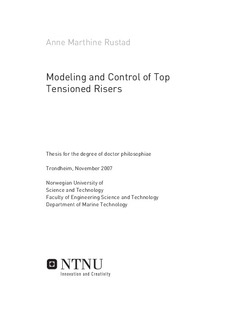| dc.description.abstract | This doctoral thesis presents new research results on the control of top tensioned risers in deep waters. The main motivation for this work is the development of a riser control system which control the top tension of the individual risers in an array, such that collisions between adjacent risers are prevented. The risk of collision increases with increasing water depth, and as the oil and gas industry is moving to ever deeper waters, riser interaction has become an issue of considerable concern. The two main design parameters to avoid collision are riser spacing and top tension, which both are expensive alternatives. Hence, new solutions are needed and dynamic control of the top tension is the solution proposed here.
A mathematical model of the riser system is developed. It includes two risers in a tandem arrangement which are connected to a tension leg platform (TLP) through their top nodes, forcing the risers to follow the prescribed motions of the TLP in the horizontal direction. In the vertical direction the riser motion is decided by the actuator which is a tensioner system. The risers are also exposed to current forces which are found by considering hydrodynamic interaction. The risers are modeled using the finite element method (FEM). This model is verified by the commercial software RIFLEX.
For the purpose of control applications, the model needs to be computationally fast, but still be able to describe the main physics of the real system. The number of elements needed to keep a desired level of accuracy is therefore investigated. Different means to measure the performance of the model are considered, and among these, payout measurements reflected the displacement of the riser in the best manner. In addition measurements at the wellhead, like payout and tension, are both accurate and available at most installations today. Hence, the proposed control objectives are mainly based on keeping the top tension, payout or total riser length equal for the risers of concern.
A simulation study showed that the dynamic variation of the riser elongation needed to be taken into account in the control algorithm for deep water risers. The reason was that the large difference between tension in the two risers resulted in a significant length difference that had to be compensated for by different payout. In shallow waters the difference between the riser elongations is smaller, and equal payout is shown to be appropriate. Equal tension, which is used by the industry today, could be applied for small current velocities. A second control objective principle was to measure the relative horizontal distance between the risers keeping it at a desired distance. This method showed promising results, but is dependent on measurements that are not easily available today. The best control objective used in the controller design was found to be equal effective length, meaning that the sum of the payout and the actual riser length should be equal for all risers. Introducing this method may reduce the needed spacing between the risers and thereby reduce the wellbay area on the TLP. A simulation study with model based supervisory switched control showed how the different controller structures and parameters could be included in the feedback loop depending on the operational conditions and riser behavior.
The main contributions in this work are the mathematical modeling of the riser/TLP system, the model analysis, and the proposed controller architecture, including the control objectives and the supervisory switched control concept. | nb_NO |
